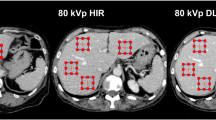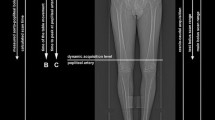Abstract
Objectives
To compare the patient radiation dose during endovascular aortic aneurysm repair (EVAR) using different types of radiological systems: a mobile fluoroscopic C-arm, mobile angiographic and fixed angiographic equipment.
Methods
Dose–area products (DAP) were obtained from a retrospective study of 147 consecutive patients, subjected to 153 EVAR procedures during a 3.5-year period. On the basis of these data, entrance surface dose (ESD) and effective dose (ED) were calculated. EVARs were performed using a fluoroscopic C-arm, mobile or fixed angiographic equipment in 79, 26 and 48 procedures, respectively.
Results
Fluoroscopy times were essentially equivalent for all the systems, ranging from 15 to 19 min. The clinical outcomes were not significantly different among the systems. Statistically significant differences among radiological equipment grouping were found for DAP (mobile C-arm: 32 ± 20 Gy cm2; mobile angiography: 362 ± 164 Gy cm2; fixed angiography: 464 ± 274 Gy cm2; P < 10−6), for ESD (mobile C-arm: 0.18 ± 0.11 Gy; mobile angiography: 2.0 ± 0.8 Gy; fixed angiography: 2.5 ± 1.5 Gy; P < 10−6) and ED (mobile C-arm: 6.2 ± 4.5 mSv; mobile angiography: 64 ± 26 mSv; fixed angiography: 129 ± 76 mSv; P < 10−6).
Conclusions
Radiation dose in EVAR is substantially less with a modern portable C-arm than with a fixed or mobile dedicated angiographic system.
Key Points
• Fluoroscopy during endovascular aortic aneurysm repair can impart a substantial radiation dose.
• Radiation doses during EVAR are higher when using mobile/fixed angiographic systems.
• Mobile C-arm fluoroscopy imparts a lower dose with an equivalent clinical outcome.
• Procedures need to be dose-optimised when using mobile/fixed angiographic systems.





Similar content being viewed by others
Abbreviations
- DAP:
-
dose–area product
- EVAR:
-
endovascular aortic aneurysm repair
- ESD:
-
entrance surface dose
- ED:
-
effective dose
References
EVAR trial participants (2005) Endovascular aneurysm repair versus open repair in patients with abdominal aortic aneurysm (EVAR trial 1): randomised trial. Lancet 365:2179–2186
Prinssen M, Verhoeven EL, Buth J et al (2004) Dutch Randomised Endovascular Aneurysm Management (DREAM) trial group. A randomised trial comparing conventional and endovascular repair of abdominal aortic aneurysms. N Engl J Med 351:1607–1618
Jones C, Badger SA, Boyd CS, Soong CV (2010) The impact of radiation dose exposure during endovascular aneurysm repair on patient safety. J Vasc Surg 52:298–302
Geijer H, Larzon T, Popek R, Beckman KW (2005) Radiation exposure in stent-grafting of abdominal aortic aneurysms. Br J Radiol 78:906–912
Kpodonou J (2010) Hybrid cardiovascular suite: the operating room of the future. J Card Surg 25:704–709
Jones DG, Wall BF (1985) Organ doses from medical X-ray examinations calculated using Monte Carlo techniques. National Radiological Protection Board, Chilton
Weerakkody RA, Walsh SR, Cousins C, Goldstone KE, Tang TY, Gaunt ME (2008) Radiation exposure during endovascular aneurysm repair. Br J Surg 95:699–702
Leeds Test Objects (2012)TOR 18FG. http://www.leedstestobjects.com. Accessed 16 May 2012
Trianni A, Bernardi G, Padovani R (2005) Are new technologies always reducing patient doses in cardiac procedures? Radiat Prot Dosimetry 117:97–101
Newton WB 3rd, Shukla M, Andrews JS et al (2011) Outcomes of acute intraoperative surgical conversion during endovascular aortic aneurysm repair. J Vasc Surg 54:1244–1250
Lipsitz EC, Veith FJ, Ohki T et al (2000) Does the endovascular repair of aortoiliac aneurysms pose a radiation safety hazard to vascular surgeons? J Vasc Surg 32:704–710
Ho P, Cheng SW, Wu PM et al (2007) Ionizing radiation absorption of vascular surgeons during endovascular procedures. J Vasc Surg 46:455–459
Padovani R, Vano E, Trianni A et al (2008) Reference levels at European level for cardiac interventional procedures. Radiat Prot Dosimetry 129:104–107
ICRP (2000) Avoidance of radiation injuries from medical interventional procedures: ICRP Publication 85. Pergamon, Oxford
Weiss DJ, Pipinos II, Longo GM, Lyinch TG, Rutar FJ, Johanning JM (2008) Direct and indirect measurement of patient radiation exposure during endovascular aortic aneurysm repair. Ann Vas Surg 22:723–729
Author information
Authors and Affiliations
Corresponding author
Rights and permissions
About this article
Cite this article
Fossaceca, R., Brambilla, M., Guzzardi, G. et al. The impact of radiological equipment on patient radiation exposure during endovascular aortic aneurysm repair. Eur Radiol 22, 2424–2431 (2012). https://doi.org/10.1007/s00330-012-2492-4
Received:
Revised:
Accepted:
Published:
Issue Date:
DOI: https://doi.org/10.1007/s00330-012-2492-4




